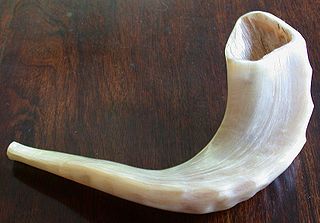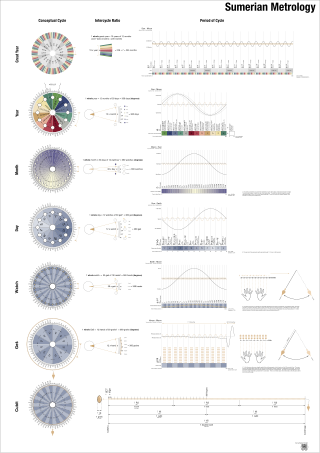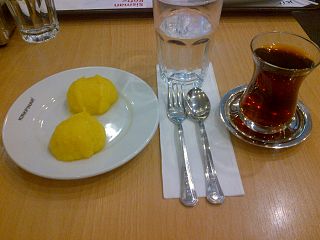
The Hijri calendar, or Arabic calendar also known in English as the Muslim calendar and Islamic calendar, is a lunar calendar consisting of 12 lunar months in a year of 354 or 355 days. It is used to determine the proper days of Islamic holidays and rituals, such as the annual fasting and the annual season for the great pilgrimage. In almost all countries where the predominant religion is Islam, the civil calendar is the Gregorian calendar, with Syriac month-names used in the Levant and Mesopotamia but the religious calendar is the Hijri one.

In astronomy, the new moon is the first lunar phase, when the Moon and Sun have the same ecliptic longitude. At this phase, the lunar disk is not visible to the naked eye, except when it is silhouetted against the Sun during a solar eclipse.

Av is the eleventh month of the civil year and the fifth month of the ecclesiastical year on the Hebrew calendar. It is a month of 30 days, and usually occurs in July–August on the Gregorian calendar.

Elul is the twelfth month of the civil year and the sixth month of the religious year in the Hebrew calendar. It is a month of 29 days. Elul usually occurs in August–September on the Gregorian calendar.

The Babylonian calendar was a lunisolar calendar used in Mesopotamia from around the second millennium BCE until the Seleucid Era, and it was specifically used in Babylon from the Old Babylonian Period until the Seleucid Era. The civil lunisolar calendar was used contemporaneously with an administrative calendar of 360 days, with the latter used only in fiscal or astronomical contexts. The lunisolar calendar descends from an older Sumerian calendar used in the 4th and 3rd millennia BCE.
Often called lunar mansion, a lunar station or lunar house is a segment of the ecliptic through which the Moon passes in its orbit around the Earth. The concept was used by several ancient cultures as part of their calendrical system.

Shish kebab or shish kebap is a popular meal of skewered and grilled cubes of meat. It can be found in Mediterranean cuisine and is similar to or synonymous with dishes called shashlik and khorovats, found in the Caucasus region.

Calpack, kalpak, or qalpaq is a Turkic high-crowned cap worn by Bulgarians, Turks, Circassians, Dagestanis, Chechens, Ukrainians, Poles, Russians and throughout Central Asia and the Caucasus.

Cağ kebabı is a horizontally stacked marinated rotating lamb kebab variety, originating in Erzurum Province, Turkey.
The Arabic names of the months of the Gregorian calendar are usually phonetic Arabic pronunciations of the corresponding month names used in European languages. An exception is the Syriac calendar used in Iraq and the Levant, whose month names are inherited via Classical Arabic from the Babylonian and Hebrew lunisolar calendars and correspond to roughly the same time of year.

Qalat or kalata (قلعه) in Persian, and qal'a(-t) or qil'a(-t) in Arabic, means 'fortress', 'fortification', 'castle', or simply 'fortified place'. The common English plural is "qalats".
The Rumi calendar, a specific calendar based on the Julian calendar, was officially used by the Ottoman Empire after Tanzimat (1839) and by its successor, the Republic of Turkey until 1926. It was adopted for civic matters and is a solar based calendar, assigning a date to each solar day.

Qurabiya, is a shortbread-type biscuit, usually made with ground almonds. Versions are found in most Arab and Ottoman cuisines, with various different forms and recipes. They are similar to polvorones from Andalusia.

The Solar Hijri calendar is a solar calendar and one of the various Iranian calendars. It begins on the March equinox as determined by the astronomical calculation for the Iran Standard Time meridian and has years of 365 or 366 days. It is the modern principal calendar in Iran and Afghanistan and is sometimes also called the Shamsi calendar and Khorshidi calendar. It is abbreviated as SH, HS or, by analogy with AH, AHSh.

Höşmerim or hoşmerim is a Turkish dessert popular in the Aegean, Marmara, Trakya and Central Anatolia regions of Turkey. It is sometimes called peynir helva or "cheese halva". It is generally consumed after a meal as a light dessert and may be topped with ice cream, honey or nuts.
Several calendars have been used in pre-Islamic Arabia. Inscriptions of the ancient South Arabian calendars reveal the use of a number of local calendars. At least some of these South Arabian calendars followed the lunisolar system. For Central Arabia, especially Mecca, there is a lack of epigraphic evidence, but details are found in the writings of Muslim authors of the Abbasid era. Some historians maintain that the pre-Islamic calendar used in Central Arabia was a purely lunar calendar similar to the modern Islamic calendar. Others concur that the pre-Islamic calendar was originally a lunar calendar, but suggest that about 200 years before the Hijra it was transformed into a lunisolar calendar, which had an intercalary month added from time to time to keep the pilgrimage within the season of the year when merchandise was most abundant.

Kalehjoosh or Kaljoosh is a popular traditional soup in Iran, Armenia, Azerbaijan, and Turkey.

Sevan Nişanyan is a Turkish-Armenian writer and lexicographer. Author of a number of books, Nişanyan was awarded the Ayşe Nur Zarakolu Liberty Award of the Turkish Human Rights Association in 2004 for his contributions to greater freedom of speech. He is also known for his work to restore Şirince, a semi-derelict village near Turkey's Aegean coast.
Saatchi is a Persian and Turkish surname and word. The word "saatchi" (sā'ātchi), which means "watchmaker", originates from Ottoman Turkish, derived from "saat" with the suffix "-çi". The Albanian surname Sahatçiu is also derived from the Turkish word "saatçi" as a result of the Ottoman rule in Albania.

Çökelek is a fermented and acid/heat coagulated fresh cheese from Turkey and Azerbaijan. It can be produced from heating fermented buttermaking by-products such as buttermilk (yayıkaltı), though skimmed milk yogurt can also be used as a starting material. It can also be obtained from yayık ayranı through heat exposure. Despite its similar appearance, it is distinct from Lor, a form of curdled whey product similar to cottage cheese. Keş, şor, ekşimik and minci are different local names associated with çökelek.














